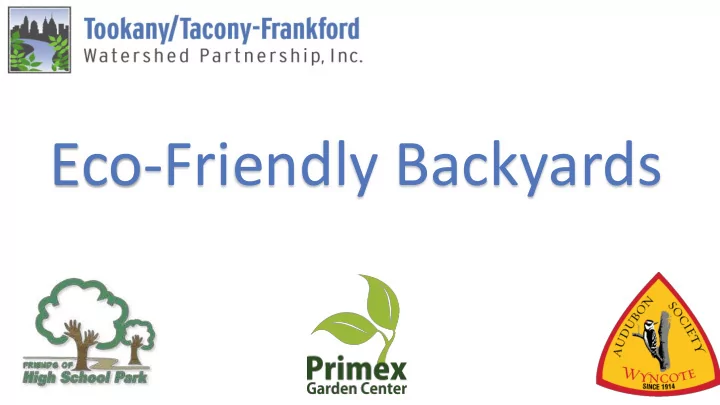

Eco-Friendly Backyards
TTF’s mission is to improve the health and vitality of the Tookany/Tacony-Frankford Creek and watershed — which includes neighborhoods in North, Northeast, and Northwest Philadelphia and Abington, Cheltenham, Jenkintown, Rockledge, and Springfield in Montgomery County — by engaging our communities in education, stewardship, restoration, and advocacy.
Abington Township Cheltenham Township • • Abington Junior High Rock Lane Park • School Glenside Elementary • Abington Friends School School • • McKinley Elementary Cedarbrook Middle School School • Ethel Jordan Park • Manor College • Sisters of St. Basil the Great Academy Philadelphia • Olney Recreation Center • Vernon Park
Creating Wildlife Habitat
What You Need to Attract Birds • Shelter - A safe environment with lots of shrubs, trees and ground cover of varied heights and diverse structure • Food - Plant for a year round food source • Water - Consistent supply • Nesting materials
Different Birds Prefer Different Types of Shelter
Birds and Many Other Animals Rely Primarily on Insects for Nutrition The diet of most adult birds consists of 85% insects but some prefer fruit, nuts, seeds, nectar or worms. 96 % of All Birds Feed Their Young Insects Exclusively • Only insects contain high enough levels of protein and calcium needed to make bones and feathers. • It takes ~6,000-10,000 caterpillars to raise one clutch of chickadee eggs Planting for Birds Means Planting for Insects
Insect Life-Cycles Egg Larva Pupa Adult Butterfly larvae eat leaves Adults eat nectar Bee larvae eat pollen
Insects Coevolved with Plants Over Millions of Years 90% of All Insect Herbivores Are Specialists • Specialists can generally use only 1-3 species or genera of plants for food – think monarch butterfly and milkweed. Baltimore • The plants that these insects eat are the native plants that they Checkerspot coevolved with over millions of years. • Exotic plants generally support very few to 0 native insects or herbivores. It is for this reason that many become invasive. White Turtlehead Spice Bush Swallowtail Spicebush Lindera benzoin
Planting for Insects and Birds Means Planting Native Plants Definition of Native- A plant or animal that has evolved in a given place over a period of time sufficient to develop complex and essential relationships with the physical environment and other organisms in a given ecological community. Goldfinch on native thistles Asclepias incarnata – Swamp Milkweed
No Pesticides for a Wildlife-friendly Garden Ecosystem Services Since less than 0.01% of all native insects Ambush bug Provided by Insects are actually pests, integrated pest management (IPM) can usually keep • Pollination infestations under control. • Control of pests Parasitic wasp • Decay of waste • Food Blue orchard bee By luring predators and parasitoids into your garden using flowers, you can effectively control most unwanted pests. Ground Beetle Parasitized Saddleback caterpillar
Food for Fall and Winter Some insects wrap themselves in leaves and fall to the ground where they overwinter. Many overwinter as eggs tucked in a casing that is camouflaged as a dead leaf. Many bees lay their eggs in hollow plant stems or in an underground nest. As summer turns to fall the metabolism of birds changes. Birds that rely on insects or nectar- producing flowers for food must migrate. Others change their diet to nuts, seeds or berries.
Water Year Round
Creating Habitat for Nesting
What You Need to Attract Butterflies and Moths • Lots of nectar sources – Red, yellow, orange, white, pink and purple flat topped or short tubed flowers • Plant flowers in the sun in sweeps or masses • Specific host plants for larvae Lonicera sempervirens- • A shallow water source with minerals Asclepias incarnata – Swamp Milkweed Trumpet honeysuckle or mud puddle Symphyotrichum ericoides - White Heath Aster Phlox panniculata- Garden Phlox Symphyotrichum lateriflorum – Calico Aster
What You Need to Attract Bees • Simple flowers – no double petal types Uvularia grandiflora- • Yellow, white, blue and purple flowers Large-Flowered Bellwort planted in masses or sweeps • Rotting wood for them to take cover or open ground to nest in underground • Water in a very shallow container • Consistent flowers from Spring to Fall Eryngium yuccifolium- Rattlesnake Master Baptisia australis – Wild Blue Indigo Rudbeckia hirta- Symphyotrichum laeve- Smooth Blue Aster Black-eyed Susan
Elements of a Wildlife-Friendly Garden • A bird bath or other source of water including mud puddles for butterflies • A consistent source of food • A source of live caterpillars or insects for the bird babies • A diverse mixture of trees and shrubs of different sizes including evergreens-Woodie plants with nuts, seeds or berries are ideal • Diverse plantings of flowers, grasses and ferns preferably planted in sweeps or clusters • No pesticides • Nesting materials like small grasses, twigs, spider webs, hollow plant stems or fuzzy plants • A safe place to nest like a birdhouse or big dead tree • Leaf litter for insect shelters- don’t rake it all up • Some bare ground for the ground nesting bees or wood for beetles and bees • A pile of branches is also good for cover
https://www.audubon.org/native-plants
Recommend
More recommend